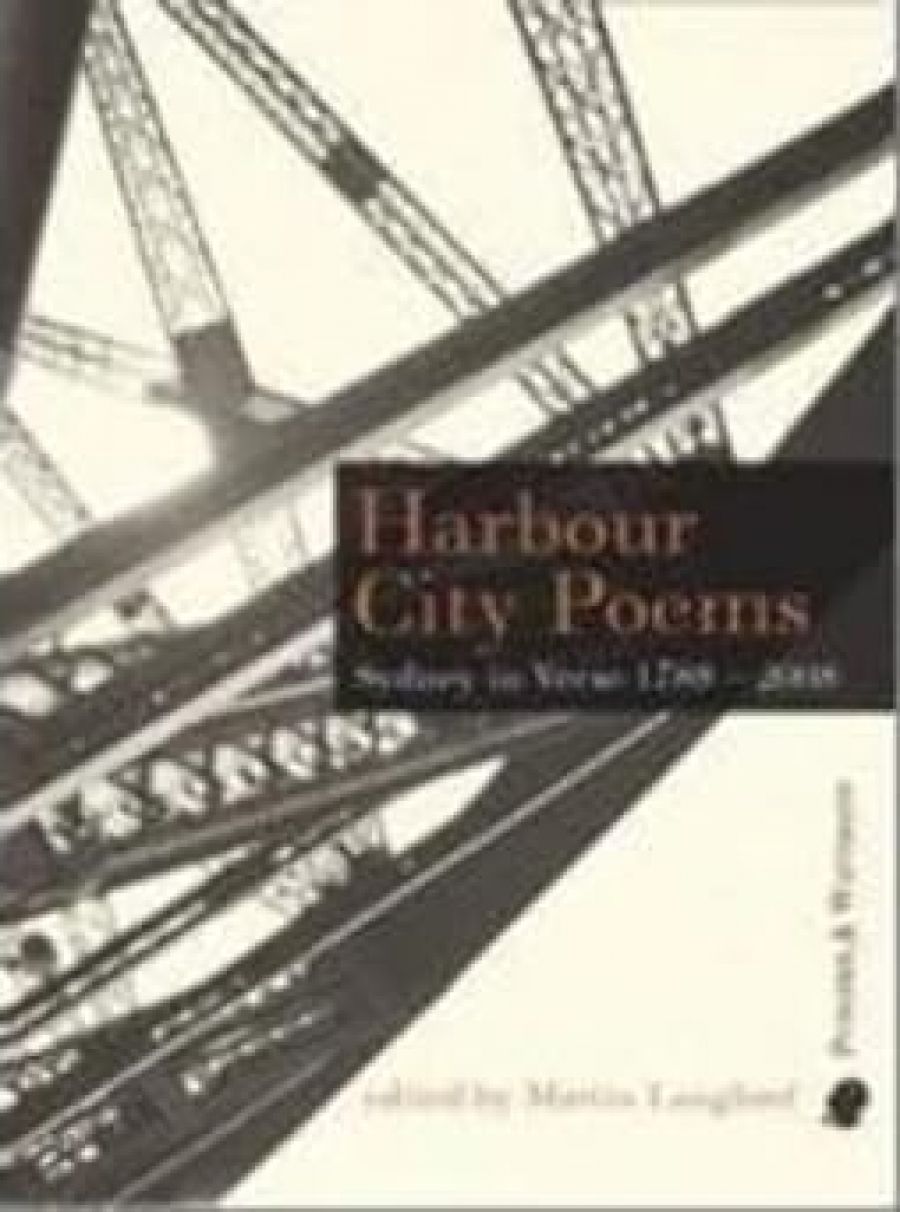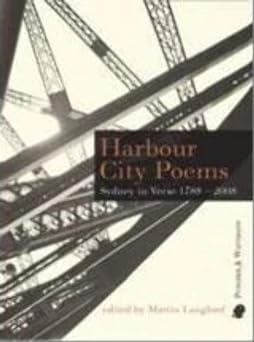
- Free Article: No
- Contents Category: Poetry
- Review Article: Yes
- Article Title: Emerald veins
- Online Only: No
- Custom Highlight Text:
‘Sydney in verse’: this anthology, arranged chronologically, presents the country’s oldest European settlement in a variety of guises – from place of exile (‘Botany Bay’) to site resistant to the colonising discourses of English Romanticism (W.C. Wentworth, Charles Harpur) to new city viewed through the lenses of symbolism (Christopher Brennan) and modernism (Kenneth Slessor), and from there to the locus of the universal, crossnational themes of joy, suffering and loss.
- Book 1 Title: Harbour City Poems
- Book 1 Subtitle: Sydney in Verse 1788–2008
- Book 1 Biblio: Puncher & Wattman, $29.95 pb, 226 pp
- Book 1 Cover Small (400 x 600):

Two problems face the anthologist of any work focused upon a geographical area: quality and the audience. Martin Langford, in the preface to this volume, states rather disarmingly that Sydney-adjacent areas such as the Hawkesbury and the Blue Mountains ‘would be better served by anthologies of their own’ (one suspects that the former might be overshadowed by the formidable talent of Robert Adamson). Round-ups of local talent are destined to attract few readers beyond a local, coterie audience (unless the locality happens to be fourteenth-century Florence); this is well and good, but gifted poets should always succeed in being published beyond parish boundaries. Its combination of historical depth with a roll-call of some of Australia’s most assured poetic voices should ensure that Harbour City Poems has an audience outside Sydney.
It is fascinating to see how many of these poems are preoccupied with Sydney as idea – something that goes beyond topography and culture to locus of the imagination; the editor refers to ‘the project to make Sydney a site in which people can invent themselves continues today’. This ‘project’, which might be seen to have its origins in Slessor’s great ‘Five Bells’, surfaces throughout the anthology, as here in Michael Farrell’s cryptically lower-case ‘sydney’:
sydney’s the
ultimate in bridging voids &
bringing the universe to itself the
atmosphere of reality mountains in
that desired hunky accessibility
In Dorothy Porter’s ‘Paradise Beach’, the heady surfeit of place becomes synonymous for a state of desire; so too in Peter Kirkpatrick’s swirling epithalamium ‘Late Summer Light’: ‘If love can be a city, may it sprawl / radiant in late summer light ...’
Sydney’s iconic topography – the Harbour, Kings Cross, the beaches, inner suburbs and city streets – is invested in these and other poems with mythic significance. The poetics of space are articulated in many of these poems by an insistence on locating experience by the markers of personal and proper names (‘Woolloomooloo’ is almost an essential ingredient, it seems, with its alluring conflation of trochee/iamb with alliteration and assonance). Slessor leads the way here, in doing for Sydney what T.S. Eliot had done to mythologise London in ‘The Waste Land’. Dorothy Hewett’s classic ‘In Moncur Street’ does something similar, changing Eliot’s horror of the demotic for a lyrical celebration of flat-dwellers in Woollahra.
In an equally intimate register of naming, Judith Beveridge’s ‘Streets of Chippendale’ (one of the finest poems in the selection) movingly blurs the boundaries between the signifiers of place and ‘Christian names’:
Streets named Ivy, Vine, Rose and Myrtle –now lack a single tree. They could have been
the homes of kindly aunts in quiet suburbs
before factories like terrible relations
moved in …
Les Murray’s ‘The Sydney Highrise Variations’ gazes corrosively at what those ‘terrible relations’ and all they signify have done to reduce the value of life: his is no life-enhancing metropolis of light, but ‘England’s buried Gulag’, the late twentieth-century equivalent of the ‘unreal cities’ represented earlier by Lawson and Brennan. The note is struck again in a less declamatory way by Alison Clark in ‘Living in the City’:
Vampire, narcissist, the movie of itself– the city
is desire in camouflage amid glass towers
and lights and the hypnotic flux of sleepwalkers ...
Sydney is constructed in many of these poems as the very antithesis of Mardi Gras, Harbour fantasies and boozy summer nights (‘the sun and salt-spray cocktail which is Sydney’, as Alan Wearne ironically observes).
On a second reading of the anthology, I was struck by the strong presence of elegy in its pages (serendipity? editorial taste? the Weinen which is the counterpoint to the hedonist’s Lachen?). From the sonorities of ‘Five Bells’ to the gentle pathos of Clive James’s ‘In Town for the March’ and Michael Dransfield’s ‘Pioneer Lane’ (a fine pair of Anzac Day poems), to the heart-wrenching memorials to loved ones by Geoffrey Lehmann and John Tranter, the elegiac strain is sounded memorably in this volume, giving the lie, perhaps, to any assumption that elegy is a cold-climate genre.
I wonder if other readers of Harbour City Poems will be struck, as I was, by the absence of young voices. Most of the poets in these pages are established figures, more or less; the youngest of them was born in 1972. Migrant experience of Sydney is represented (by Andy Kissane and Paul Dawson) but there are no Asian or Mediterranean names among the list of contributors. There are two works by indigenous writers, Dennis McDermott and Peter Minter, but why not a single poem voiced in a distinctive Koori voice? Kevin Gilbert’s ‘Redfern’, that angry writing-back to Lawson’s ‘Faces in the Street’, cries out for inclusion.
The editor should be thanked for restricting his selection to poems which have real merit; the few exceptions concern mainly the early material, such as John Thompson’s windy ‘Sydney Scherzo’ (‘O brooch on the breast of a continent in the caress of the sea!’). Sydney as emblem of a new land, as correlative, as myth, as symbol, as site of joy and suffering – this anthology covers some lively imaginative terrain, and represents some distinguished poetic voices. Despite a smattering of typographical errors, Puncher & Wattman are to be congratulated on an elegant volume, with a pleasing design, semi-hard binding and paper designed to resist the Sydney sunlight.


Comments powered by CComment